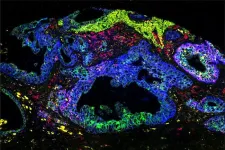(Press-News.org) Picture walking outside on a dark, cloudless evening. You look up to admire the stars — maybe even a planet, if you’re lucky — and a sense of wonder washes of you. New research from the University of Washington shows this might be more than a memorable experience: It could ultimately spark scientific curiosity and influence life choices.
Rodolfo Cortes Barragan, research scientist the UW Institute for Learning and Brain Sciences (I-LABS), and Andrew Meltzoff, co-director of I-LABS and professor of psychology, recently co-authored a study in Nature Scientific Reports showing a link between the ability to see the stars unblocked by light pollution and an interest in astronomy.
UW News spoke with the authors about their study and its surprising implications for broadening access to science and education.
Where did the idea for this study come from?
Rodolfo Cortes Barragan: As psychologists, we know that changes to the environment can impact people’s behavior. Yet, the changes brought upon by light pollution — a hot topic in astronomy, biology and environmental science — have received little attention from the social sciences. We considered it important to examine how light pollution might affect the human mind, focusing on the consequences of light pollution for human emotions and scientific behavior.
Andrew Meltzoff: Astronomy often functions as a “gateway” to science as a whole. People, including young children, look up and are enchanted by seeing the starry night sky. They feel a sense of wonder which triggers curiosity about themselves and the universe. Many famous astronomers have remarked that they got their start in science based on childhood experiences of wondering about the night sky. We decided to study these reports scientifically.
How do you define the feeling of wonder about the universe?
RCB: The feeling of “wonder” is a particular conjunction of emotions. It involves awe and amazement. It involves curiosity — the desire to know more. It is joyful. It involves elation.
To examine wonder, we made use of a nationally representative survey conducted by the Pew Research Center of more than 35,000 U.S. residents. This survey included a question about peoples’ “wonder about the universe.” We combined these results with previously reported detailed physical measurements of light pollution. We found that U.S. populations that live under low light pollution report feeling more “wonder about the universe.” This was a specific relationship. Light pollution was not linked to other emotions that were assessed in the same Pew survey, but it was strongly connected to wonder.
Just as importantly, we found that “wonder about the universe” was directly related to peoples’ behavioral interest in astronomy. We used a wide array of measures of interest in astronomy, including behaviors like using Google to search for “astronomy,” signing up to have one’s name sent to Mars aboard the Perseverance rover, and even applying to become a NASA astronaut. In other words, the data showed us that, in locations in the U.S. where light pollution is low, feelings of wonder about the universe and interest in astronomy are high. Features of the physical environment are linked to people’s psychological experience as well as their actual behavior.
Can you elaborate on the idea raised in the paper that light pollution is an equity issue?
RCB: We all want all children, and adults, to have the equal opportunity for inspiration and for science. But what our results are suggesting is that people within the U.S., depending on where they live, do not have equitable access to the dark night sky, which often promotes an interest in science. If you can’t experience something, it is not as easy to become motivated by it.
AM: If a child grows up in an environment where they don’t see the stars, they’re not as likely to ask childlike questions about them: “Why do the stars twinkle?” or “How many are there up there?” It's a powerful experience for a child to be able to see the Milky Way and the Big Dipper, but many children don’t have that opportunity anymore. Seeing the starry night sky may change kids’ behavior in a good way. For example, if a child can see the stars, they might go read up on astronomy or space exploration and begin to dream. Astronomy may indeed be a “gateway” science that draws children, both boys and girls, into curiosity-driven programs and social clubs.
What’s the big picture you want to convey about this study?
RCB: We hope that our study inspires more research along these lines, and that this work combining psychology and astronomy will trigger the “I wonder” reflex in other scientists, prompting interdisciplinary work across the arts and sciences.
AM: This study brings together two wonders that have inspired scientists and poets over the ages — the heavens above and our human actions on earth. One is studied by astronomers and the other by psychologists. Can we connect the two? A childlike question to be sure, but one that motivates us to try to dig deeper and find out more.
This study was funded by Stanford University Diversifying Academia, Recruiting Excellence (DARE) Doctoral Fellowship Program, the National Science Foundation’s Broadening Participation Postdoctoral Research Award and the Bezos Family Foundation.
For more information, Rodolfo Cortes Barragan at barragan@u.washington.edu and Andrew Meltzoff at meltzoff@uw.edu.
END
Q&A: UW researchers examine link between light pollution and interest in astronomy
2024-10-02
ELSE PRESS RELEASES FROM THIS DATE:
PCORI awards $37 million to accelerate implementation of evidence-based health research
2024-10-02
WASHINGTON, D.C., Oct. 2, 2024 — The Patient-Centered Outcomes Research Institute (PCORI) today announced $37 million in funding awards through its Health Systems Implementation Initiative (HSII). These awards will support 25 projects implementing PCORI-funded comparative clinical effectiveness research (CER) findings in participating HSII health systems.
Key Points:
Twenty-five HSII participant health systems, covering more than 2,300 care sites across the country, received PCORI funding awards.
HSII implementation projects will focus on one of two main areas:
Improving antibiotic ...
Researchers develop insights into KRAS mutations in pancreatic cancers
2024-10-02
A common mutation in the KRAS gene is associated with improved overall survival in pancreatic ductal adenocarcinoma (PDAC) compared with other variants, in part because the mutation appears to lead to less invasiveness and weaker biological activity, according to a multicenter study conducted at Weill Cornell Medicine, NewYork-Presbyterian, Memorial Sloan Kettering Cancer Center, and other institutions.
The research, published August 29 in Cancer Cell, demonstrates that KRAS mutations, which occur in about 95 percent of people who ...
New CAMH-led study highlights effective treatment for male postpartum depression
2024-10-02
(Toronto, Canada) – A new study from the Centre for Addiction and Mental Health (CAMH), in collaboration with leading researchers in Pakistan, has demonstrated the effectiveness of an integrated psychosocial intervention aimed at improving parenting skills and symptoms of depression. The treatment was effective for male postpartum depression (PPD) in a cohort of Pakistani fathers, improving both paternal mental health and child development outcomes.
“Male mental health, and especially postpartum depression in fathers, remains a stigmatized and understudied area,” says Dr. Ishrat Husain, the study's lead investigator and senior ...
Global study highlights the life-saving impact of Guideline-Directed Medical Therapy (GDMT) in heart failure patients
2024-10-02
Heart failure is a rapidly growing public health issue that can be difficult to manage on a global scale. But there are tools that exist that can improve outcomes, such as guideline-directed medical therapy (GDMT). New UCLA-led research highlights the important role that these guidelines can play in reducing mortality rates for individuals suffering from heart failure with reduced ejection fraction (HFrEF), a type of heart failure affecting an estimated 29 million people worldwide.
“These guidelines are being significantly underutilized in clinical settings globally and there ...
New method quantifies single-cell data’s risk of private information leakage
2024-10-02
Access to publicly available human single-cell gene expression datasets, or scRNA-seq datasets, has significantly enhanced researchers’ understanding of both complex biological systems and the etymology of various diseases. However, the increase in accessibility raises a greater concern about the privacy of the individuals who donated the cells and the likelihood of their private health details being shared without consent.
Previous studies on these privacy breaches have focused on bulk gene expression data sharing, where the average expression levels of genes are measured across a large population of cells from a tissue or sample rather than an individual cell. Because single-cell ...
Eyes on the fries: how our vision creates a food trend
2024-10-02
KEY POINTS
Human judgement of food images is influenced by judgements that precede it
Experiment tested reactions of more than 600 people making food choices
Highly relevant given widespread use of Uber Eats or phone-based menus
Finding could assist treatments for eating disorders or assist with food marketing
Research at the University of Sydney has revealed that we don’t judge food simply on its merits but are influenced by what we have seen beforehand, a cascading phenomenon known as ‘serial dependence’.
The research, published today in the high-impact journal Current Biology, was conducted by Professors David Alais ...
UVM scientist maps fruit fly brain
2024-10-02
A team of scientists supported by the National Institutes of Health (NIH)’s The BRAIN Initiative®, including Davi Bock, Ph.D., Associate Professor of Neurological Sciences at UVM’s Robert Larner, M.D. College of Medicine, recently made a substantial advancement in neurobiological research by successfully mapping the entire brain of Drosophila melanogaster, more commonly known as the fruit fly.
The study, titled “Whole-brain annotation and multi-connectome cell typing of Drosophila,” recently published ...
Bridging the gap: how pragmatic trials can better serve healthcare systems
2024-10-02
Boston, MA – A new thought piece led by the Harvard Pilgrim Health Care Institute with collaborators from Duke University and Kaiser Permanente Washington Health Research Institute highlights the challenges facing healthcare researchers and decision makers in the quest to improve population health in a constantly evolving healthcare landscape. The authors offer strategies to enhance the effectiveness of pragmatic clinical trials and increase their impact on real-world healthcare settings.
The Viewpoint appears October 2 in JAMA.
Pragmatic clinical trials, designed to inform health ...
UChicago scientists decode key mutation in many cancers
2024-10-02
Inside every cell, inside every nucleus, your continued existence depends on an incredibly complicated dance. Proteins are constantly wrapping and unwrapping DNA, and even minor missteps can lead to cancer.
A new study from the University of Chicago reveals a previously unknown part of this dance—one with significant implications for human health.
In the study, published Oct. 2 in Nature, a team of scientists led by UChicago Prof. Chuan He, in collaboration with University of Texas Health Science Center at ...
NYU Langone awarded $1.6 million to investigate Alzheimer’s & Parkinson’s progression through the eye
2024-10-02
Researchers at NYU Langone Health were awarded $1.6 million from the National Institutes of Health (NIH) to investigate changes in the eye that may indicate early signs of Alzheimer’s disease and Parkinson’s disease.
The award, OT2OD038130, recognizes the eye as a part of the brain and its role as a window into cognitive and visual health. After the initial $1.6 million award, the grant may renew an additional two years, for a total of $4.8 million as part of the NIH Common Fund Venture Program’s new Oculomics Initiative. Oculomics is a relatively new term to describe the integrative use of technology and ...




